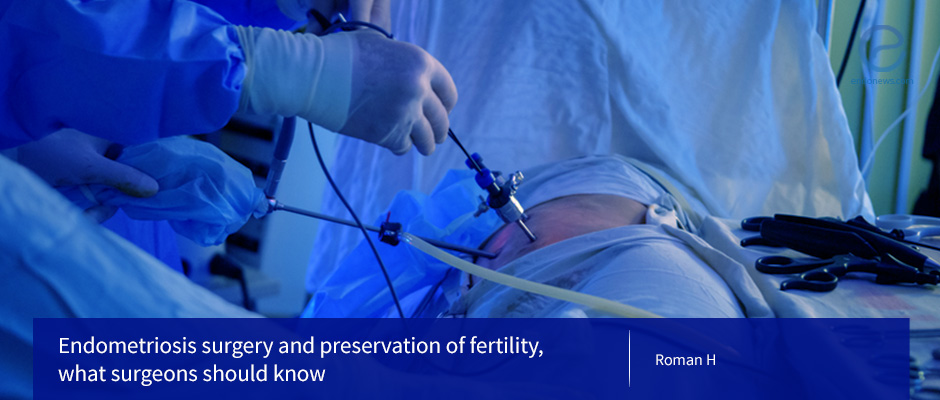Endometriosis surgery and preservation of fertility, what surgeons should know
May 7, 2018
Weighing the post-operative benefits and fertility outcomes in women with endometriosis
Key Points
Highlights:
- In surgical management of endometriosis, potential benefits and complications between excising all endometriotic lesions and potential fertility impairment should be weighed.
Key Results:
- Complete excision of all endometriotic lesions via surgery should not be performed at the expense of a woman’s reproductive health.
- Laparoscopic surgery for colorectal endometriosis increases the chances of spontaneous conception compared to laparotomy
- Two main techniques are available for endometriotic cyst removal:
- Ovarian cystectomy: Involves excision of the endometriotic cyst wall
- Ablation: Involves the destruction of the internal surface of the cyst using laser or plasma energy. Both of these techniques have comparable rates of post-operative pregnancy.
- Surgical treatment of ovarian endometrioma should be tailored according to the patient's wishes for future conception and to the pre-operative ovarian reserve.
What’s done here?
- This is a discussion on the surgical management of endometriosis with an emphasis on preventing damage to reproductive organs.
Limitations:
- This is an opinion article.
Lay Summary
Endometriosis can involve most of the pelvic organs including the uterus, ovaries and fallopian tubes and thus has the potential to cause infertility. This article titled, “Endometriosis surgery and preservation of fertility, what surgeons should know” written by H. Roman and published in the Journal of Visceral Surgery aims to discuss several surgical indications for surgery in women with endometriosis. An overarching consideration in the management of surgery is to weigh the potential benefits and complications between excising all endometriotic lesions and potentially impairing fertility. Furthermore, a discussion is needed to evaluate patient’s desire for future conception (and how the patient plans on being pregnant) and preoperative ovarian reserve. These are important aspects in the surgical planning of the endometriosis patient because some forms of conception require preservation of the uterus and at least one ovary whereas if the patient needed bilateral tubal destruction or bilateral salpingectomy, IVF is the only chance of conception for that patient. Surgeons should also take note that the mere presence of conserved ovarian tissue is not sufficient to allow conception, because egg quality and reserve need to be assessed.
Depending on the location of endometriotic lesions and the severity of endometriotic lesions, the woman can present with many different symptoms. Additionally, surgical management of different forms of endometriosis depends not only on the characteristics and localization of the endometriosis lesions but also on the characteristics of the patient (age, parity, subsequent desire for pregnancy, symptoms).
Two main techniques exist for the removal of endometriotic cysts. Ovarian cystectomy, which includes the excision of the endometriotic cyst wall, and ablation, which is the destruction of the internal surface of the cyst using lasers or plasma energy. Both methods are comparable with each other when assessing post-operative spontaneous pregnancy rates. Ablation is a technique that aims to completely destroy of endometrial epithelium surrounded by stroma, which is responsible for the growth and recurrence of cysts. This is in contrast to cyst excision since the fibrotic layer surrounding the endometrial epithelium is left in place.
Often, patients have multiple endometriomas. In these cases, the main objective should be that of the preservation of the ovarian reserve. This major objective outweighs that of complete eradication of ovarian cysts. In other words, the surgeon should err on the side of recurrent endometriosis due to incomplete treatment of ovarian lesions rather than risk a severe reduction of ovarian reserve following complete resection of endometriomas in patients who are planning on conceiving. Recurrence seems to still be a major concern for both surgeons and women with endometriosis. The probability of recurrence seems to depend directly on the postoperative resumption of menses and the use of oral contraceptives after surgery. Therefore, continuous OC administration with menstrual suppression is recommended after surgery in those patients who wish to wait before attempting to become pregnant.
The surgical management of deeply-infiltrating endometriosis (DIE) is also unique. Endometriosis is considered deep when lesions infiltrate the subperitoneal space to a depth beyond 5 mm. Apart from the symptoms due to these infiltrations (dyschesia, diarrhea, constipation, urinary frequency, defecatory and micturition urgency), endometriosis can have serious consequences such as bowel obstruction or kidney injury. The management of patients with severe DIE who desire pregnancy is currently hotly debated and to date requires more randomized-control studies to assess whether surgery is beneficial for post-operative IVF. However, having the surgery earlier rather than later will mean less aggressive and potentially less morbid surgery risks and lessening of previous symptoms. In all cases of endometriosis and especially in those with DIE, specialized teams are needed for the multidisciplinary management of young patients with endometriosis.
Research Source: https://www.ncbi.nlm.nih.gov/pubmed/29709485
endometriosis surgery fertility medication pregnancy

